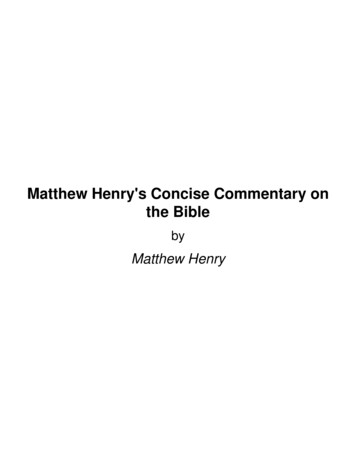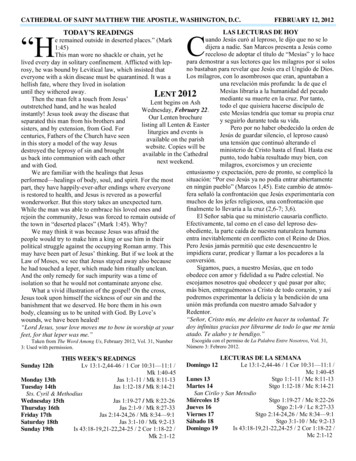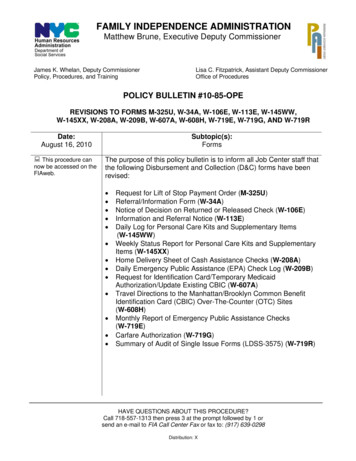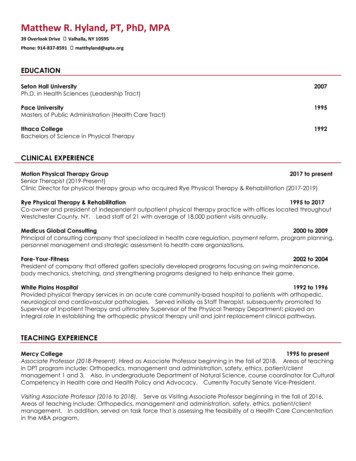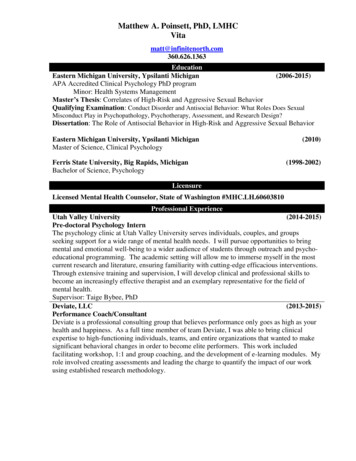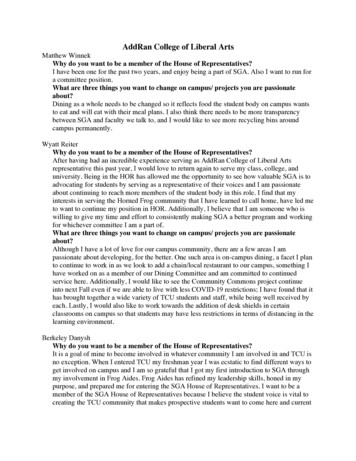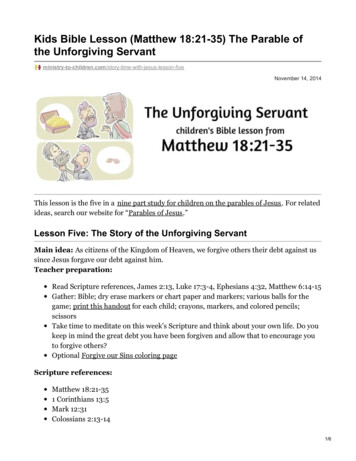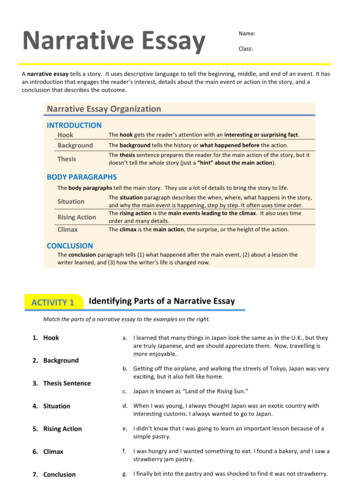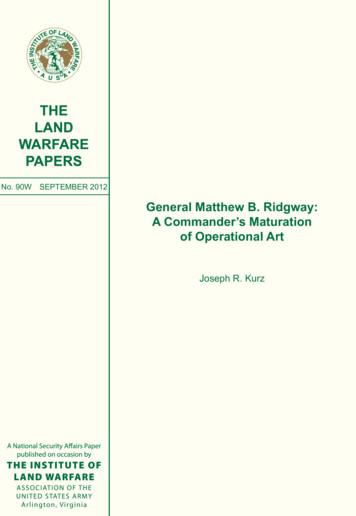
Transcription
No. 90WSepTEMBER 2012General Matthew B. Ridgway:A Commander’s Maturationof Operational ArtJoseph R. Kurz
General Matthew B. Ridgway:A Commander’s Maturation of Operational ArtbyJoseph R. KurzThe Institute of Land Warfareassociation of the United states army
AN INSTITUTE OF LAND WARFARE PAPERThe purpose of the Institute of Land Warfare is to extend the educational work of AUSA by sponsoringscholarly publications, to include books, monographs and essays on key defense issues, as well asworkshops and symposia. A work selected for publication as a Land Warfare Paper represents researchby the author which, in the opinion of ILW’s editorial board, will contribute to a better understandingof a particular defense or national security issue. Publication as an Institute of Land Warfare Paper doesnot indicate that the Association of the United States Army agrees with everything in the paper but doessuggest that the Association believes the paper will stimulate the thinking of AUSA members and othersconcerned about important defense issues.LAND WARFARE PAPER NO. 90W, September 2012General Matthew B. Ridgway:A Commander’s Maturation of Operational ArtbyJoseph R. KurzLieutenant Colonel Joseph R. Kurz was commissioned a second lieutenant, Armor, through theReserve Officers Training Corps at the University of Central Florida in 1995. He served in 2d Battalion,37th Armor, 1st Armored Division as a tank platoon leader and support platoon leader and deployedwith a United Nations peacekeeping force to the Former Yugoslavia Republic of Macedonia. Underthe branch detail program, he transferred to the Quartermaster branch and continued serving in thedivision’s 501st Forward Support Battalion as a supply platoon leader and supply accountable officer.From 1999 through 2003, he served in the 3d Infantry Division as a brigade maintenance managerand later as a company commander in the 703d Main Support Battalion. From 2004 through 2009, heserved in several Army special operations forces assignments including support operations officer in theSpecial Operations Sustainment Brigade and later, in 3d Special Forces Group as the Group S-4 and 3dGroup Support Battalion executive officer. He has deployed in support of Operations Iraqi Freedom andEnduring Freedom. He has served as the Deputy J-5, Future Plans, Combined Forces Special OperationsComponent Command–Afghanistan. He is currently serving as the battalion commander of 1st GroupSupport Battalion, 1st Special Forces Group at Joint Base Lewis-McChord, Washington.LTC Kurz earned a Bachelor’s Degree in Public Administration from the University of CentralFlorida, a Master’s Degree in Logistics Management from the Florida Institute of Technology and aMaster’s Degree in Military Art and Science from the School of Advanced Military Studies, U.S. ArmyCommand and General Staff College. His other military schools include the Armor Officer Basic Course,the Combined Logistics Officer Advanced Course, the Combined Arms and Services Staff School, theLogistics Executive Development Course and the U.S. Army’s Command and General Staff College.This paper represents the opinions of the author and should not be taken to represent the viewsof the Department of the Army, the Department of Defense, the United States government, theInstitute of Land Warfare, or the Association of the United States Army or its members. Copyright 2012 byThe Association of the United States ArmyAll rights reserved.Inquiries regarding this and future Land Warfare Papers should be directed to: AUSA’s Instituteof Land Warfare, Attn: Director, ILW Programs, 2425 Wilson Boulevard, Arlington VA 22201,e-mail sdaugherty@ausa.org or telephone (direct dial) 703-907-2627 or (toll free) 1-800-3364570, ext. 2627.ii
ContentsForeword. vIntroduction. 1Leader Development. 4Education. 4Training. 5Mentorship. 6Learning from Failure. 6Operation Husky. 7Operation Neptune. 9Operation Market. 12Mastering Operational Art. 13Battle of the Bulge. 13Operation Varsity. 16Conclusion. 19Implications. 20Recommendations. 20Appendix. 21Endnotes. 22Bibliography. 27iii
iv
ForewordCurrent U.S. Army doctrine specifies for commanders a model of understanding, visualizing, describing, directing, leading and assessing operations. Within Army missioncommand, posits this author, the most important subcomponent of visualization depends onthe 11 elements of operational art. Those elements are the template used here in considering the factors of General Matthew B. Ridgway’s maturation of operational art through fivecombat operations.During World War II, Ridgway commanded the 82d Airborne Division in OperationsHusky and Neptune, and then the XVIII Airborne Corps in Operation Market, the “Battle ofthe Bulge” and Operation Varsity. According to the author, he achieved tactical success butdid not adequately apply operational art for Husky, Neptune and Market. He learned fromhis failures and progressively improved his application of operational art during the Bulgeand Varsity.This monograph, through an investigation into available primary sources—field orders,after-action reports and personal accounts reinforced with secondary source analysis—demonstrates that Ridgway overcame inadequacy. Although he completed all the militaryeducation available in his era, it was only after the intense crucible of three combat operations that he eventually applied operational art successfully.Ridgway’s astonishing ability to visualize a military campaign matured based on hisleader development and the lessons he learned from failure and from personally masteringoperational art.Gordon R. SullivanGeneral, U.S. Army RetiredPresident, Association of the United States Army4 September 2012v
vi
General Matthew B. Ridgway:A Commander’s Maturation of Operational ArtAll your study, all your training, all your drill anticipates the moment when abruptlythe responsibility rests solely on you to decide whether to stand or pull back, or toorder an attack that will expose thousands of men to sudden death.General Matthew B. Ridgway1IntroductionOn 22 December 1950, the situation for the Eighth U.S. Army fighting in Korea wasdire. Eighth Army had previously advanced through nearly the entire expanse of the KoreanPeninsula to its northern boundary at the Yalu River. It abandoned the capital city of Pyongyangand retreated below the 38th Parallel that centrally divided the peninsula because of an attackby two hundred thousand Chinese. Eighth Army had already lost every bit of its fighting spirit,and then its commander, General Walton Walker, died in a jeep accident.2 Less than four dayslater, Lieutenant General Matthew B. Ridgway assumed command. He immediately met withSupreme Allied Commander General Douglas A. MacArthur and Eighth Army’s subordinatecorps commanders to gain understanding of the situation. Next he visited the soldiers on thefront lines to get a sensing of the enemy and the operating environment. Thus began Ridgway’svisualization of how future military operations should unfold.3General Ridgway developed this astonishing ability of accurately visualizing militaryoperations through the means of a solid foundation of leader development combined withcombat experience. Over the course of the first 24 years of his career, he received professional schooling through the Army’s educational institutions. Key training assignments—suchas nearly three years at the War Department, War Plans Division (WPD)—reinforced his education. Moreover, his World War II combat experiences—including several failures duringOperations Husky, Neptune and Market, followed by successes in the Battle of the Bulge andOperation Varsity—solidified his ability to quickly and accurately assess and then visualizecombat operations. Well-developed leadership and extensive combat experience produced acommander capable of rapidly visualizing an entire campaign and reversing an all-but-lostsituation. General Ridgway so successfully visualized and reversed the deteriorating situationin Korea that, within five months, President Harry S. Truman had named Ridgway SupremeCommander, Allied Powers, replacing MacArthur.41
General Matthew Bunker Ridgway (1895–1993) was one of the United States Army’sgreatest general officers; he commanded at every level, finishing his 38 years of service as the19th Chief of Staff, Army. Throughout his career, he demonstrated that determination in everyduty assignment and educational program led to more advanced duty assignments and educational programs. General Ridgway was a 1917 graduate of the United States Military Academy,a 1935 graduate of the Army Command and General Staff School and a 1937 graduate of theArmy War College. Several prominent figures mentored General Ridgway in his life, amongthem four men who eventually became the Army’s four five-star generals: Generals of the ArmyGeorge C. Marshall, Dwight D. Eisenhower, Douglas A. MacArthur and Omar N. Bradley.5During World War II, General Ridgway served as commander of the 82d Airborne Divisionthrough Operations Husky and Neptune and later as commander of the XVIII Airborne Corpsthrough Operation Market, at the Battle of the Bulge and during Operation Varsity. During theKorean War, he served as field army commander of the Eighth U.S. Army. Late in his career,Ridgway served twice as a theater commander and twice as supreme commander of alliedforces.6 He reached the zenith of the Army Officer Corps having led thousands of soldiers inbattle through two wars, first at the operational level and then at the strategic level.Throughout the years that Ridgway served, the U.S. Army did not recognize the operational level of war, as it currently does, as the intermediate level between battlefield tacticsand national strategy.7 Although several prominent military theorists in the late 19th and early20th centuries wrote extensively about operational art, U.S. Army doctrine did not incorporatethe concept, nor did professional military schools teach it, during Ridgway’s era. Yet Ridgwayeventually applied operational art based on an informed vision that facilitated the integrationof ends, ways and means across the levels of war.Current U.S. Department of Defense doctrine defines operational art as theapplication of creative imagination by commanders and staffs—supported by their skill,knowledge and experience—to design strategies, campaigns and major operations andorganize and employ military forces. Operational art integrates ends, ways, and meansacross the levels of war.8Army operational-level commanders visualize this integration based on an understanding oftheir environment and reliance on personal factors of their education, experience, intellect, intuition and creativity.9 U.S. Army doctrine prescribes that commanders exercise mission commandthrough a model of “understanding, visualizing, describing, directing, leading and assessing operations” (see figure 1).10 The second of the six components—visualization—is the most importantand the one that Ridgway eventually mastered. In the Army, the concept of mission command isthe application of “leadership to translate decisions into actions—by synchronizing forces andwarfighting functions in time, space and purpose—to accomplish missions.”11 The operationalcommander first starts to “understand” by recognizing the national strategic end state, the enemyand analyzing operational variables.12 Following understanding, the operational commander thenmust “visualize” operations. Commanders do so based on visualization subcomponents such asprinciples of war, operational themes, experience, running estimates and the elements of operational art. The most important subcomponent of visualization is the elements of operational art,of which there are 11 listed in U.S. Army doctrine: end state and conditions; centers of gravity;direct or indirect approach; decisive points; lines of operation or effort; operational reach; tempo;simultaneity and depth; phasing and transitions; culmination; and risk (see appendix for keyterms and definitions). How did General Matthew Ridgway’s visualization mature?2
LeadPMESII-PT Principles of war Operational themes ExperienceUnderstandThe Problem Operational environment EnemyMETT-TCVisualizeDescribeThe End State and the Natureand Design of the OperationTime, Space, Resources,Purpose and Action Offense Defense Stability Civil support Decisive operations Shaping operations Sustaining operationsDirectWarfighting Functions Movement and maneuver Intelligence Fires Sustainment Mission command ProtectionRunning estimatesElements of operational art Initial commander’s intent Planning guidance Commander’s critical informationrequirements Essential elements of friendlyinformation Plans and orders Branches and sequels Preparation ExecutionAssessMETT-TC mission, enemy, terrain and weather, troops and support available, time available, civil considerationsPMESII-PT political, military, economic, social, information, infrastructure, physical environment, timeFigure 1: Understand, Visualize, Describe, Direct, Lead and Assess, (U.S. Army FM 3-0).13To understand how Ridgway’s ability to visualize matured, this study first reviewed howRidgway’s visualization began in his leader development; it then analyzed several primarysources in determining when he learned from the experiences of failure and, finally, when hesucceeded. Primary sources reviewed regarding Ridgway’s leader development include theRegulations Governing the System of Military Education in the Army, Annual Report of theSecretary of War 1920, United States Army Field Service Regulations 1923, The Papers ofGeorge Catlett Marshall and Annual Report for the Command and General Staff School Year1933–1934, as well as General Ridgway’s own memoirs. Key historical accounts from themilitary schools—such as History of the U.S. Army War College and Military History of theU.S. Army Command and General Staff College, among other relevant secondary works—reinforced these sources. Primary sources analyzed regarding Ridgway’s combat experienceinclude actual reports of operations, administrative orders and field orders issued by Ridgway’sheadquarters. Among these reports are “82d Airborne Division in Sicily and Italy,” “Report ofNormandy Operations,” “Summary of Operations 18 December 1944 to 13 February 1945”and “Summary of Ground Forces Participation in Operation Varsity.” In most cases, Ridgwayhimself signed these after-action reports. The Army Field Service Regulations from 1941 statedthat a “decision as to a specific course of action is the responsibility of the commander alone.While he may accept advice and suggestions from any of his subordinates, he alone is responsible for what his unit does or fails to do.”14 This study analyzed the results of Ridgway’s firstfive sequential combat experiences for the absence or presence of the elements of operationalart. Since Ridgway bore total responsibility for the results of the operations, it is logical that3
he would have conceptualized the operations ahead of time. The presence of these elementsproves that not only did the organizations mature, but so did Ridgway’s visualization. By hissixth combat experience, Ridgway demonstrated superior vision that had not been evident inhis first combat experience. The thesis of this study is that General Matthew Ridgway’s visualization of operations matured based on his leader development and what he learned fromfailure and from mastering operational art.Leader DevelopmentGeneral Matthew B. Ridgway completed all the military education available in his erastarting with the USMA at West Point, New York, and followed by courses at the InfantrySchool at Fort Benning, Georgia, then the Army Command and General Staff School (CGSS)and finally the Army War College (AWC). Developmental assignments—such as teaching atUSMA, serving as Assistant Chief of Staff for Operations and Training (G-3) at field-armylevel, and planning experience at the War Department— reinforced Ridgway’s education.Additionally, several general officers, including Marshall, MacArthur and General Frank R.McCoy, directly mentored Ridgway. These Army educational institutions, key training experiences and mentorship from senior officers collectively formed the pillars of General Ridgway’sleader development and the foundation necessary for mastering operational art.EducationBuilding on the core leadership values West Point taught him, Ridgway attended theCompany Commander’s Course and the Infantry Advanced Course at the Infantry School atFort Benning. Infantry officers expected to attend these two courses in their careers. However,Ridgway’s selection for attendance at CGSS and the AWC marked the trajectory of an extraordinary career. In 1933, Ridgway entered CGSS, a highly selective school focused on preparingofficers to command large Army organizations. The two-year CGSS curriculum provided fieldgrade student officers with in-depth doctrinal knowledge drawn from the Army’s experiencesin the First World War. CGSS was critical to Ridgway’s leader development. The mission ofCGSS at the time wastraining officers in: 1) the combined use of all arms in the division and the army corps;2) the proper functions of commanders of division and or army corps; and 3) the properfunctions of General Staff officers of divisions and army corps.15Complementing the Army capstone doctrine for operations at the time—the U.S. Army FieldService Regulations, published in 1923—CGSS taught Ridgway the principles of combat operations. According to historian Peter J. Schifferle, CGSS taught combined arms, effectivecommand and control, a reliance on firepower, a consistent doctrine, a thorough knowledge ofthe principles of operations, knowledge of large formations, the science of war and problemsolving.16 Ridgway benefitted from what author Timothy K. Nenninger recognized: that theheart of the course, “tactical principles and decisions,” consisted of increasinglycomplex tactical problems involving increasingly large combined arms formations.The entire curriculum emphasized the command process, involving interaction betweencommanders and general staff officers, and tactical decision making.17Just two years later, the Army selected Matthew Ridgway for the capstone of the officer education system, what Ridgway considered “the most advanced school in the Army,” the Army WarCollege.184
AWC prepared senior field-grade officers for commanding the Army’s largest organizationsthrough a curriculum focused on carefully planning the execution of joint combat operations.AWC taught its student officers, including Matthew Ridgway, to think and plan joint campaignslinking strategy to the tactical level. Historian Henry G. Gole observed, “The [AWC] missionwas to prepare officers to command echelons above corps [and] to prepare officers for duty inthe War Department General Staff.”19 Unlike CGSS, which prepared him for the organizationand functioning of divisions and corps, AWC taught Ridgway strategic warfare through practicalapplication methods. According to historian Harry P. Ball, the AWC curriculum in 1937 requiredRidgway to conduct planning using scenarios of the “Rainbow Plans” developed concurrentlywith the War Plans Division. Additionally, Gole discovered, “In the years between 1934 and1940, AWC classes conducted systematic planning for coalition warfare against Japan, versusJapan and Germany, and for hemispheric defense with Latin American allies.”20 It is particularlyinteresting that one of the plans was the “Orange” plan, in which students considered “coalition warfare, hypothesizing a situation in which the United States would align itself with GreatBritain, China, and the Soviet Union against Japan.”21 Ridgway practiced, albeit in a classroomsetting, campaigning beside Russians, whose military theorists, Mikhail Tukhachevsky andAleksandr A. Svechin, initially developed operational art more than a decade earlier.22With USMA, the Infantry Courses, CGSS and the AWC, Ridgway possessed the institutional knowledge he needed for commanding large organizations in war. However, thateducation comprised only a third of the essential leader development. Subsequent to thesecourses, Ridgway reinforced his knowledge through practical applications.TrainingThree key training assignments reinforced Ridgway’s education. Early in his career,he served as an instructor at West Point. Later, he served as the Assistant Chief of Staff forOperations and Training (G-3) at Second Army; then, on the eve of World War II, he servednearly three years at the War Department’s War Plans Division (WPD).In September 1918, only 16 months after graduating from USMA and with only the experience of one noncombat assignment along the Mexican border, Ridgway was selected for ateaching position at the academy. He remained there for six years, teaching Spanish and tacticsand serving as the athletic director. The cyclic, fundamental leader development of cadets, yearafter year, solidified Ridgway’s personal leader development as a company-grade officer.Ridgway’s next great training experience was serving as the G-3 (Operations and Training)at Second Army, headquartered in Chicago, where he planned training maneuvers and commandpost exercises.23 It was Ridgway’s first field-grade officer assignment after graduating fromCGSS, and he implemented the staff lessons he had learned in school. With war looming inEurope, Ridgway took the assignment seriously and pushed himself to visualize how mechanized forces would maneuver across farm fields in Michigan. Ridgway did everything he couldto survey the terrain, including conducting an aerial reconnaissance from an open-cockpit,two-seat airplane in freezing temperatures. In his memoirs he recounted his serious approachto visualizing the training:Even after we were so far committed that it would be impossible to change the plans, Iwould wake up at night in a cold sweat, visualizing hosts of angry farmers chasing mewith pitch-forks because their cornfields had been ruined. I had proved to be a prettygood school soldier, but this thing wasn’t on paper. It was real.245
The Army recognized Ridgway’s determination in planning as the G-3 and later rewarded himwith another prominent training opportunity.In September 1939, the Army selected Matthew Ridgway for an assignment considered indicative of general-officer potential; service in the WPD at the War Department inWashington, D.C. There, his primary responsibility was planning for contingency operationsthroughout Latin America.25 Ridgway made great use of more than 22 years of training experience and the lessons of the AWC by directly applying his knowledge to the planning effortsat WPD. Additionally, while at WPD Ridgway enjoyed a close working relationship withGeneral Marshall and the benefit of his mentorship.MentorshipThe advantage of relationships with more experienced senior officers completedRidgway’s total leader development. Generals MacArthur, McCoy and Marshall mentoredRidgway at various points in his career prior to World War II. Marshall, more so than theothers, seemed to have close and frequent direct contact with Ridgway. In 1922, Ridgwaycommanded a company in the 15th Infantry Regiment stationed in Tientsin, China; his battalion commander was George C. Marshall.26 The two men’s paths crossed several moretimes. Marshall was assistant commandant of the Infantry school when Ridgway graduatedat the top of his advanced course class, and Marshall recognized his “dramatic talent.”27Marshall was impressed once again with the younger man’s performance when Marshalloversaw Ridgway’s training exercises in Michigan. In a personal letter to Ridgway afterwards, Marshall wrote, “You personally are to be congratulated for the major success of allthe tactical phases of the enterprise . . . did such a perfect job that there should be some wayof rewarding you other than saying it was well done.”28 In May 1939, Marshall—at that timealready identified as the next Chief of Staff, Army—detailed Ridgway, then still a major, toaccompany him on a diplomatic mission to Rio de Janeiro. Marshall and Ridgway traveledby ship and “had long conversations” on the cruise to Brazil. On that trip, Marshall solicitedRidgway’s thoughts for rebuilding the Army, and Ridgway’s competence, according to historian Harold Winton, pulled him deeper into Marshall’s “circle of confidants.”29 Ridgway’snext assignment was his tour at WPD, where he was Marshall’s daily operations briefer.30Later, as Chief of Staff, Marshall drew upon his past observations of officers rotating throughthe Infantry school, the AWC and working in the WPD in selecting the best for division andcorps commands in the Second World War. In 1942, Matthew Ridgway was one of Marshall’spicks for a division.31Learning from FailureGeneral Ridgway commanded the 82d Airborne Division in Operation Husky in Sicilyand Operation Neptune in Normandy. Later, he commanded the XVIII Airborne Corps inOperation Market in the Netherlands. In all three instances, forces under Ridgway’s commandachieved considerable tactical success. However, there is little evidence that Ridgway appliedoperational art in these three operations. In Sicily, not one of the 11 elements of operationalart is evident. In Normandy, Ridgway applied three of the 11 elements of operational art. InHolland, six of the 11 were present in planned operations for which Ridgway bore responsibility. The progressive application of the elements of operational art in these three sequentialoperations indicates that General Ridgway’s operational art, informed by his ability to visualize, was beginning to develop. In Husky, Ridgway’s leader development was not enough.6
Operation HuskyThe airborne assault invasion into Sicily was both the first combat test for General MatthewB. Ridgway and the first test for employing the airborne division.32 Although Ridgway had developed skill and knowledge, he lacked combat experience; all three characteristics are requiredin the operational art definition. He prepared the 82d Airborne Division through intensive training conducted in North Africa, but Operation Husky was marked with insufficient resources,inconsistent command and control measures and no unity of effort. Although units of the 82dAirborne Division achieved tactical success, there was no evidence to indicate that Ridgwaylinked tactics to strategic ends or had an adequate visualization of operations.There is sufficient evidence to support this claim, beginning with the comprehensive reportof operations from the 82d Airborne Division Headquarters published in 1945, accounting thedivision’s experiences in Sicily and Italy. A key fact in that report was the mission as issued byII Corps to the 82d for its 505th Parachute Infantry Regiment (PIR):(1) Land during the night D-1/D in area N and E of Gela, capture and secure highground in that area; (2) disrupt communications and movement of reserves duringnight; (3) be attached to 1st Infantry Division effective H 1 hours on D-Day; and (4)assist 1st Infantry Division in capturing and securing landing field at Ponte Olivo.33The mission for the remainder of the 82d Airborne was to(a). . . concentrate rapidly by successive air lifts in Sicily by D 7, in either or both theDIME (45th Infantry Division) or JOSS (3d Infantry Division) areas . . . and (b) 2dBattalion, 509th Parachute Infantry remain in North Africa in reserve, available fordrop mission as directed.34The report also contained an after-action report (AAR) provided by the 505th PIR commander, Colonel James M. Gavin, submitted to General Ridgway a month after the airborneassault
principles of war, operational themes, experience, running estimates and the elements of opera-tional art. the most important subcomponent of visualization is the elements of operational art, of which there are 11 listed in U.S. Arm


